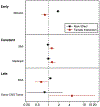Heart Transplantation: An In-Depth Survival Analysis
- PMID: 32535125
- PMCID: PMC7725193
- DOI: 10.1016/j.jchf.2020.03.014
Heart Transplantation: An In-Depth Survival Analysis
Abstract
Objectives: This study aims to understand the complex factors affecting heart transplant survival and to determine the importance of possible sex-specific risk factors.
Background: Heart transplant allocation is primarily focused on preventing waitlist mortality. To prevent organ wastage, future allocation must balance risk of waitlist mortality with post-transplantation mortality. However, more information regarding risk factors after heart transplantation is needed.
Methods: We included all adults (30,606) in the Scientific Registry of Transplant Recipients database who underwent isolated heart transplantation from January 1, 2004, to July 1, 2018. Mortality (8,278 deaths) was verified with the complete Social Security Death Index with a median follow-up of 3.9 years. Temporal decomposition was used to identify phases of survival and phase-specific risk factors. The random survival forests method was used to determine importance of mortality risk factors and their interactions.
Results: We identified 3 phases of mortality risk: early post-transplantation, constant, and late. Sex was not a significant risk factor. There were several interactions predicting early mortality such as pretransplantation mechanical ventilation with presence of end-organ function (bilirubin, renal function) and interactions predicting later mortality such as diabetes and older age (donor and recipient). More complex interactions predicting early-, mid-, and late-mortality existed and were identified with machine learning (i.e., elevated bilirubin, mechanical ventilation, and dialysis).
Conclusions: Post-heart transplant mortality risk is complex and dynamic, changing with time and events. Sex is not an important mortality risk factor. To prevent organ wastage, end-organ dysfunction should be resolved before transplantation as much as possible.
Keywords: heart transplantation; mechanical circulatory support; mortality; outcome assessment; sex.
Copyright © 2020 American College of Cardiology Foundation. Published by Elsevier Inc. All rights reserved.
Conflict of interest statement
The authors have reported that they have no relationships relevant to the contents of this paper to disclose.
Figures





References
-
- Organ Procurement and Transplantation Network: Policies. Available at: http://optn.transplant.hrsa.gov/PoliciesandBylaws2/policies/pdfs/policy_.... Accessed December 4, 2019.
-
- Cogswell R, John R, Estep J, et al. An early investigation of outcomes with the new 2018 donor heart allocation system in the United States. J Heart Lung Transplant 2020;39:1–4. - PubMed
-
- Colvin M, Smith JM, Hadley N, et al. OPTN/SRTR 2017 annual data report: heart. Am J Transplant 2019;19 suppl 2:323–403. - PubMed
Publication types
MeSH terms
Grants and funding
LinkOut - more resources
Full Text Sources
Medical

